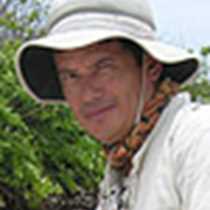Floreana Island
Floreana is considered the most mysterious island in Galápagos, and the reason is because of the people who disappeared long ago. In the morning we landed at Post Office Bay, the same place that was used for the whalers and buccaneers in the 16th and 17th centuries to send letters to their relatives. Nowadays we do the same. Our guests know that the old barrel was, for many years, the only way to get current news from the world. The Baroness and Dr. Ritter lived here and used the same barrel and their control of it was one the reasons they had so many conflicts.
The weather conditions today were excellent. The water was very clear and some sea turtle tracks were seen from the Zodiacs before landing. The landscape has not changed for many years, just the old pieces of metal behind the barrel looked more rusty.
After breakfast we started one of the most beautiful snorkeling trips of this week around Champion Islet. The water was again very clear and calm, helping us to identify many species of tropical fish and varieties of invertebrates on the rocks.
A group of juvenile sea lions swam with us the entire time and sometimes one of them, the most curious, tried to touch our masks with its nose. From the water I saw a mockingbird chasing a small finch, and a group of swallow tailed gulls resting on small crevices. A guest asked me if the mockingbird would be safer on Champion than on Floreana. This was because earlier I was talking about the mockingbird population disappearing from Floreana Island because of the cat’s predation. I pictured the distance in between the two places and I told him yes, because it is not possible for a cat to swim across to the islet. ‘I hope so anyway,’ I thought to myself.
In the afternoon, we disembarked at Punta Cormorant and began to walk, looking for pieces of olivine, the semi-precious mineral that causes the greenish color of the beach. We found many small pieces, and many starfish. Maybe sea lions were here playing with them outside the water.
Walking along the beach, we arrived at the flamingo’s lagoon where we saw a few of them, but this is normal in Galápagos. After a short walk we arrived at the second beach, the white one; from here we saw a group of sea turtles waiting for their chance to come and nest. On the beach we saw evidence that sea turtles had been laying their eggs the previous night because many tracks had been left in both directions, to and from the sea.
We were just crossing the last part of the beach when something caught our attention; a group of frigate birds digging holes with their long bills. The incredible part of that is that they do it without touching the ground, just flying.
Just before the sunset, we came back to the National Geographic Islander. From the sky deck I saw the Pajas Hill and I remembered the years I lived here when I was a child.



